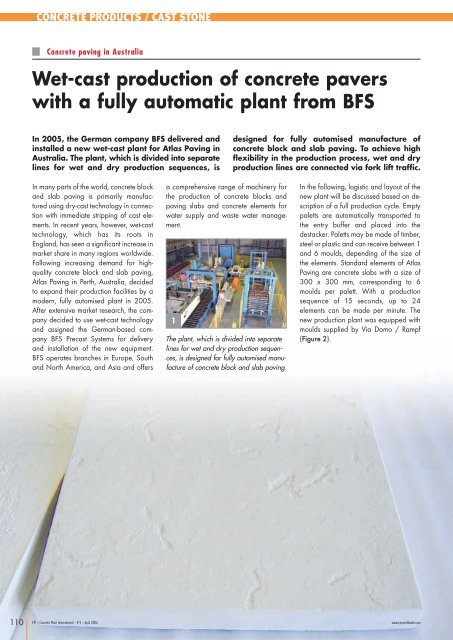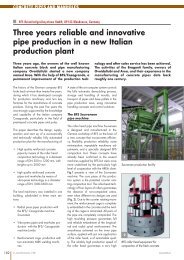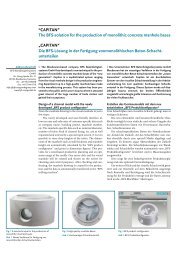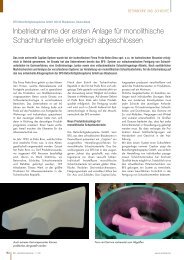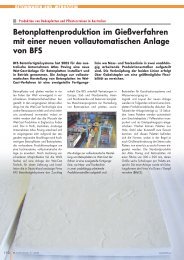Wet-cast production of concrete pavers with a fully ... - BFS GmbH
Wet-cast production of concrete pavers with a fully ... - BFS GmbH
Wet-cast production of concrete pavers with a fully ... - BFS GmbH
You also want an ePaper? Increase the reach of your titles
YUMPU automatically turns print PDFs into web optimized ePapers that Google loves.
110<br />
CONCRETE PRODUCTS / CAST STONE<br />
� Concrete paving in Australia<br />
<strong>Wet</strong>-<strong>cast</strong> <strong>production</strong> <strong>of</strong> <strong>concrete</strong> <strong>pavers</strong><br />
<strong>with</strong> a <strong>fully</strong> automatic plant from <strong>BFS</strong><br />
In 2005, the German company <strong>BFS</strong> delivered and<br />
installed a new wet-<strong>cast</strong> plant for Atlas Paving in<br />
Australia. The plant, which is divided into separate<br />
lines for wet and dry <strong>production</strong> sequences, is<br />
In many parts <strong>of</strong> the world, <strong>concrete</strong> block<br />
and slab paving is primarily manufactured<br />
using dry-<strong>cast</strong> technology in connection<br />
<strong>with</strong> immediate stripping <strong>of</strong> <strong>cast</strong> elements.<br />
In recent years, however, wet-<strong>cast</strong><br />
technology, which has its roots in<br />
England, has seen a significant increase in<br />
market share in many regions worldwide.<br />
Following increasing demand for highquality<br />
<strong>concrete</strong> block and slab paving,<br />
Atlas Paving in Perth, Australia, decided<br />
to expand their <strong>production</strong> facilities by a<br />
modern, <strong>fully</strong> automised plant in 2005.<br />
After extensive market research, the company<br />
decided to use wet-<strong>cast</strong> technology<br />
and assigned the German-based company<br />
<strong>BFS</strong> Pre<strong>cast</strong> Systems for delivery<br />
and installation <strong>of</strong> the new equipment.<br />
<strong>BFS</strong> operates branches in Europe, South<br />
and North America, and Asia and <strong>of</strong>fers<br />
a comprehensive range <strong>of</strong> machinery for<br />
the <strong>production</strong> <strong>of</strong> <strong>concrete</strong> blocks and<br />
paving slabs and <strong>concrete</strong> elements for<br />
water supply and waste water management.<br />
1<br />
The plant, which is divided into separate<br />
lines for wet and dry <strong>production</strong> sequences,<br />
is designed for <strong>fully</strong> automised manufacture<br />
<strong>of</strong> <strong>concrete</strong> block and slab paving<br />
designed for <strong>fully</strong> automised manufacture <strong>of</strong><br />
<strong>concrete</strong> block and slab paving. To achieve high<br />
flexibility in the <strong>production</strong> process, wet and dry<br />
<strong>production</strong> lines are connected via fork lift traffic.<br />
In the following, logistic and layout <strong>of</strong> the<br />
new plant will be discussed based on description<br />
<strong>of</strong> a full <strong>production</strong> cycle. Empty<br />
paletts are automatically transported to<br />
the entry buffer and placed into the<br />
destacker. Paletts may be made <strong>of</strong> timber,<br />
steel or plastic and can receive between 1<br />
and 6 moulds, depending <strong>of</strong> the size <strong>of</strong><br />
the elements. Standard elements <strong>of</strong> Atlas<br />
Paving are <strong>concrete</strong> slabs <strong>with</strong> a size <strong>of</strong><br />
300 x 300 mm, corresponding to 6<br />
moulds per palett. With a <strong>production</strong><br />
sequence <strong>of</strong> 15 seconds, up to 24<br />
elements can be made per minute. The<br />
new <strong>production</strong> plant was equipped <strong>with</strong><br />
moulds supplied by Via Domo / Rampf<br />
(Figure 2).<br />
CPI – Concrete Plant International – # 2 – April 2006 www.cpi-worldwide.com
CONCRETE PRODUCTS / CAST STONE<br />
Depending on the size <strong>of</strong> the elements, paletts receive up to 6<br />
moulds<br />
A <strong>production</strong> sequence <strong>of</strong> 15 seconds<br />
guarantees efficiency<br />
Individual palettes are automatically removed from the destacker<br />
and transported via a control station to the cleaning station where<br />
the whole palett is tilted to remove <strong>concrete</strong> scrap, dust, and other<br />
loose particles from the moulds. The cleaning is solely done by<br />
the influence <strong>of</strong> gravity, no washing or sucking devices have to be<br />
used. In the oiling station, which <strong>BFS</strong> developed especially for this<br />
type <strong>of</strong> <strong>production</strong> plant, all moulds are automatically and evenly<br />
sprayed <strong>with</strong> mould release oil. The oiling station is designed<br />
to provide the exact quantity <strong>of</strong> oil to bottom and sides <strong>of</strong> the<br />
moulds, using specially developed spray pistols. All types <strong>of</strong><br />
moulds, independent <strong>of</strong> size or shape, can be treated <strong>with</strong> the setup<br />
<strong>with</strong>out having to change the spray pistols. The readily oiled<br />
moulds are now transported via another control station to the feeding<br />
unit, were they are filled <strong>with</strong> fresh <strong>concrete</strong>.<br />
Colouring is controlled via 2 separate<br />
<strong>concrete</strong> feeding units<br />
The mixing plant consists <strong>of</strong> 2 separate mixers <strong>with</strong> capacities <strong>of</strong><br />
500 l each. Pigments are mixed into the <strong>concrete</strong> mixes according<br />
to specifications. The final <strong>concrete</strong> mix is combined from two<br />
differently coloured mixes, using exact proportions according to<br />
colour specifications <strong>of</strong> the product. For this, the 2 different mixes<br />
are placed into different feeding units and transported to a specially<br />
designed colour-mixing apparatus. Once the final mix is prepared<br />
it is fed into the distribution boxes (Figure 3). For this <strong>production</strong><br />
step it is <strong>of</strong> great importance that there is always sufficient<br />
<strong>concrete</strong> to fill the distribution boxes. The filling <strong>of</strong> the moulds is<br />
done via a number <strong>of</strong> separate proportioning containers. The filling<br />
volume <strong>of</strong> the containers can be adjusted, which can be controlled<br />
manually or automatically. Depending on the situation, the<br />
proportioning containers can be used <strong>with</strong> different sequences.<br />
www.cpi-worldwide.com CPI – Concrete Plant International – # 2 – April 2006<br />
2<br />
�
112<br />
CONCRETE PRODUCTS / CAST STONE<br />
3<br />
The final <strong>concrete</strong> mix is combined from<br />
two differently coloured mixes, using<br />
exact proportions according to colour<br />
specifications <strong>of</strong> the product<br />
Following the filling <strong>of</strong> the moulds, the<br />
Paletts are transported to the vibrating<br />
tables. Since the <strong>production</strong> sequence <strong>of</strong><br />
15 second is not sufficient to compact the<br />
<strong>concrete</strong> thoroughly, the paletts are passed<br />
through 2 vibration tables, which are<br />
positioned after each other, to guarantee<br />
optimum compaction. The paletts are now<br />
transported via a control station to the<br />
stacker, where they are pushed into the<br />
bottom <strong>of</strong> the stack and lifted upwards on<br />
arrival <strong>of</strong> the next palett. With about 15<br />
paletts one stack is complete but the number<br />
<strong>of</strong> paletts per stack can be varied<br />
according to the situation. The completed<br />
stacks <strong>of</strong> paletts are picked up at the exit<br />
buffer by fork lifts and transported to the<br />
curing area. Atlas operates 2 fork lifts for<br />
this purpose. The curing area is big<br />
enough to accommodate all pallets produced<br />
during one working day. The <strong>concrete</strong><br />
members are cured <strong>with</strong>out special<br />
treatment and simply left to air-dry in their<br />
moulds.<br />
The complete <strong>production</strong><br />
cycle <strong>of</strong> the plant is controlled<br />
by 2 workers only<br />
Once curing has been completed the<br />
paletts are transported <strong>with</strong> fork lifts to the<br />
entry buffer <strong>of</strong> the demoulding plant. The<br />
destacker removes the paletts individually<br />
from the stack and transports them to the<br />
stripping station. One worker controls the<br />
product quality at the destacker to ensure<br />
that the <strong>concrete</strong> members meet the requirements.<br />
Stripping <strong>of</strong> moulds is done automatically<br />
and all moulds <strong>of</strong> a palett are<br />
stripped at the same time (Figure 4).<br />
Empty moulds are transported via an<br />
automatic conveyor system back to the<br />
entry buffer <strong>of</strong> the wet-line where the<br />
whole <strong>production</strong> cycle starts again.<br />
4<br />
Stripping <strong>of</strong> the moulds is done automatically<br />
and all moulds <strong>of</strong> a palett are<br />
stripped at the same time<br />
5<br />
A protection foil is placed between the<br />
surfaces <strong>of</strong> the <strong>pavers</strong><br />
The stripped <strong>concrete</strong> members are transported<br />
to the turning station where they<br />
are stacked on paletts, every second layer<br />
<strong>of</strong> <strong>concrete</strong> members being placed face<br />
down onto the face <strong>of</strong> the previous layer.<br />
A protection foil is placed between the<br />
faces <strong>of</strong> the members to ensure high qua-<br />
6<br />
lity <strong>concrete</strong> surfaces. This is done <strong>with</strong><br />
specially designed equipment (Figure 5).<br />
The delivery paletts are filled <strong>with</strong> approximately<br />
8 – 10 layers <strong>of</strong> products and<br />
subsequently strapped <strong>with</strong> 10 mm thick<br />
straps at the strapping station. In the <strong>fully</strong><br />
automatic thermo shrinking station, plastic<br />
sheets are pulled over the whole paletts<br />
and shrunk. The paletts are now ready for<br />
delivery and transported via a conveyor<br />
belt to the storage plant (Figure 6).<br />
High quality Polyurethane<br />
moulds guarantee first class<br />
surface textures<br />
Atlas Paving is one <strong>of</strong> the leading manufacturers<br />
<strong>of</strong> trendy products <strong>with</strong> modern<br />
design. The <strong>concrete</strong> <strong>pavers</strong> produced<br />
<strong>with</strong> the new plant receive a high quality<br />
reconstituted Limestone finish. For this surface<br />
texture, Atlas appointed Via Domo<br />
<strong>GmbH</strong>, part <strong>of</strong> the company Rampf<br />
Formen, to develop a <strong>concrete</strong> paver<br />
system <strong>with</strong> Limestone finish and manufacture<br />
the respective Polyurethane<br />
moulds. The Limestone texture in the<br />
mould surfaces was formed as a negative<br />
from original rocks taken from the<br />
German mountain range Schwäbische<br />
Alb. Figures 7 to 9 show this classic and<br />
beautiful paving, which cannot be distinguished<br />
from a natural floor. The elements<br />
are dimensioned <strong>with</strong> very tight tolerances,<br />
which is why the moulds had to be<br />
The completed delivery paletts are transported via a conveyor belt to the storage plant<br />
CPI – Concrete Plant International – # 2 – April 2006 www.cpi-worldwide.com
7<br />
Joint detail <strong>of</strong> the <strong>pavers</strong><br />
8<br />
Bullnose <strong>of</strong> the <strong>pavers</strong><br />
9<br />
Standard paving slab <strong>with</strong> dimensions <strong>of</strong> 350 x 350 x 60 mm<br />
10<br />
Double-mould for half-sized elements<br />
www.cpi-worldwide.com CPI – Concrete Plant International – # 2 – April 2006
CONCRETE PRODUCTS / CAST STONE<br />
manufactured <strong>of</strong> a dimensionally very stable<br />
Polyurethane material. The tight joints<br />
between the <strong>pavers</strong> demand constant and<br />
exact element dimensions. A Polyurethane<br />
material, which was originally developed<br />
for sealing technology in mechanical<br />
engineering, meets these requirements<br />
(Figures 10, 11). High mechanical<br />
strength in connection <strong>with</strong> very little<br />
water sorption are the key to the success<br />
<strong>of</strong> the moulds.<br />
Atlas Paving – leading<br />
<strong>concrete</strong> paving producer<br />
in Western Australia<br />
11<br />
Standard mould, made from high quality,<br />
dimensionally stable Polyurethane<br />
Atlas Group started 1954 <strong>with</strong> the <strong>production</strong><br />
<strong>of</strong> lime silica bricks and expanded<br />
their product range 1991 by <strong>concrete</strong><br />
<strong>pavers</strong> manufactured <strong>with</strong> dry-<strong>cast</strong> technology.<br />
The new <strong>BFS</strong> <strong>production</strong> plant<br />
was commissioned in 2005. In view <strong>of</strong><br />
increasing demand for high quality <strong>concrete</strong><br />
<strong>pavers</strong> in and around Perth, this<br />
investment will surely pay <strong>of</strong>f. The product<br />
range <strong>of</strong> the company includes various<br />
<strong>concrete</strong> block and slab <strong>pavers</strong>, which<br />
can be supplied in a range <strong>of</strong> different<br />
colours. In addition to the typical brick<br />
shape <strong>pavers</strong> (230 x 115 x 50 (or 60)<br />
mm) and interlocking <strong>pavers</strong>, square slabs<br />
<strong>with</strong> dimensions between 190 x 190 and<br />
300 x 300 mm are produced in thickness<br />
<strong>of</strong> 50 or 60 mm. For paver <strong>production</strong>,<br />
Atlas has a total <strong>of</strong> 53 employees in their<br />
only factory. The <strong>production</strong> area spreads<br />
for about 100 ha, 35 ha <strong>of</strong> which are<br />
covered <strong>with</strong> a ro<strong>of</strong>, and includes storage<br />
capacity for 4,000 t <strong>of</strong> aggregate and<br />
silos for 350 t <strong>of</strong> cement. Monthly <strong>production</strong><br />
<strong>of</strong> <strong>concrete</strong> <strong>pavers</strong> is approximately<br />
8,600 t. In addition to the new wet-<strong>cast</strong><br />
plant, Atlas is considering to purchase<br />
another press for the <strong>production</strong> <strong>of</strong> <strong>concrete</strong><br />
<strong>pavers</strong> <strong>with</strong> dry-<strong>cast</strong> technology in<br />
order to keep up <strong>with</strong> the demand.<br />
�<br />
Further information:<br />
<strong>BFS</strong> – Betonfertigteilsysteme <strong>GmbH</strong><br />
Dr.-Georg-Spohn-Str. 31<br />
D - 89129 Blaubeuren, GERMANY<br />
T +49 7344 960314<br />
F +49 7344 4710<br />
v.nusser@sasagrandegroup.com<br />
www.bfs-casagrande.de<br />
RAMPF FORMEN <strong>GmbH</strong><br />
Altheimer Str. 1<br />
D – 89604 Allmendingen, GERMANY<br />
T +49 7391 505111<br />
F +49 7391 505187<br />
www.rampf.de<br />
Atlas Group<br />
Alexander Drive, Malaga<br />
Perth, WA, AUSTRALIA<br />
T +61 8 9249 1422<br />
F +61 8 9249 3575<br />
sales@atlas-group.com.au<br />
www.atlas-group.com.au


